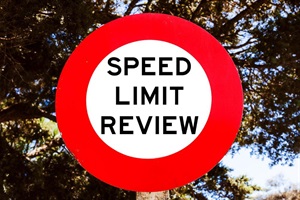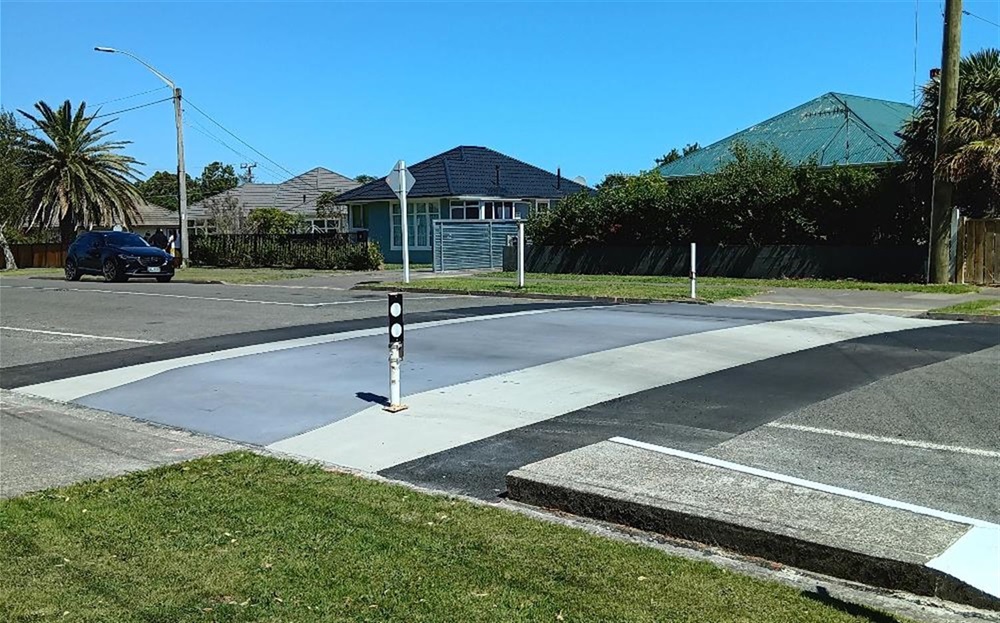
We are completing a review of our speed limits to provide safer roads for all road users – and we want your feedback.
The review will determine appropriate speed limits on local roads and prioritise areas with the highest needs first – schools – and district locations where informal and/or inappropriate speed limits are already in place.
Good speed management is fundamental to road safety, which is recognised internationally as the most effective way to reduce deaths and serious injuries.
The work initially began as the result of the previous government’s – and Waka Kotahi NZTA – requirements to reduce speed limits around schools and to formalise a number of existing unofficial speed limits within the district.
Submissions closed on Wednesday, 20 March 2024.
What's happened so far
In November last year, our Strategy and Policy Committee approved consultation with the community around these speed limits. At that time Waka Kotahi NZTA required all road controlling authorities to have achieved speed reductions in around 40% of all district schools before the end of June this year.
Since then councils have been informed that the government is reviewing the previous Land Transport Rule and the June deadline no longer applies.
We have decided to continue as planned under the Traffic and Speed Limits Bylaw 2017 which requires a Statement of Proposal to be adopted (this was adopted by the Strategy and Policy Committee on 15 February 2024).
It is proposed that any changes to speed limits will be adopted by 30 June 2027.
 School speed limits
School speed limits
School speed limits are a way of managing vehicle speeds in these areas.
Speed limits contribute significantly to the overall road safety outside schools.
Safe and appropriate speed limits create a safer environment for all road users and significantly reduce the risk of serious harm or death in the event of an accident.
It is known that 30km/h is the highest speed at which a pedestrian and car collision is usually survivable. In some cases, a lower safe and appropriate speed limit will be made in combination with other (supporting) infrastructure like raised platforms and/or speed humps.
What are the options for school speed limits?
School speed limits (reducing speed limits near schools to 30km/h or 40km/h depending on location)
|
|
Advantages
|
Disadvantages
|
|
Reducing speed limits around schools
|
- Slower speeds around schools
- Creates safer environment for students, school staff and visitors/parents
- Provides a safe and appropriate speed limit
- Reduces the chances of serious injury or death from accidents
- Encourages active transport modes for school students
- Cost of implementing signage changes
- Minimal increase to vehicle trip times
|
- Cost of implementing signage changes
- Minimal increase to vehicle trip times
|
|
Not reducing speed limits around schools
|
- Requires no changes to the bylaw
- No cost
|
- Higher risk of serious injury or death as a result of accident
- Existing speed limits are not considered safe or appropriate for school environment
|
Unofficial and inappropriate speed limits
Unofficial speed limits are those where a speed limit is in place but is not legally enforceable. An example of this is within the grounds of aged-care facilities where a speed limit is posted but has no formal recognition and is not legally enforceable. This includes areas like Jane Winstone Retirement Village, Kowhainui, Mowhanau Holiday Park, Castlecliff Golf Club and Springvale sports complexes.
Inappropriate speed limits are where the current posted speed limit is not appropriate for the road conditions or nearby activities. Examples include roads within Springvale Park, Pukenamu Queen's Park, Landguard Road and Aramoho Cemetery.
What are the options for unofficial and inappropriate speed limits?
|
|
Advantages
|
Disadvantages
|
|
Formalise unofficial speed limits (preferred option)
|
- Slower speeds
- Creates safer environment for all road user types
- Provides a safe and appropriate speed limit
- Reduces the chances of serious injury or death from accidents
- Encourages active transport modes for users
|
- Cost of implementing signage changes
- Minimal increase to vehicle trip times
|
|
Retain existing speed limits (status quo)
|
- Requires no changes to bylaw
- No cost
|
- Higher risk of serious injury or death as a result of accident
- Existing speed limits are not considered safe or appropriate for the locations under consideration
|
Consultation and submissions
Submissions closed on Wednesday, 20 March 2024.
The hearing of submissions was is scheduled for Wednesday, 10 April 2024 at the main council building at 101 Guyton Street.
Frequently asked questions
Why are you reducing speeds?
We are using local knowledge and data to make sure we have done everything we can to make our roads safer. Our aim is to make sure that our local roads have travel speeds that match the risk. Our first stage is focused on safer speeds around schools and locations around the district where informal speed limits are already in place.
Speed isn't the problem – drivers are. Why aren’t you focusing on them?
Even the most skilled drivers make mistakes. Most drivers understand that New Zealand’s roads can be challenging. Good speed management gives drivers the cues they need to judge the safe and appropriate speed for the road they are on. We are also actively promoting road safety with school children and through public education campaigns.
What is good speed management?
Good speed management is when technology, data, first-hand observation and local knowledge are used to inform interventions to make a road safer for everyone. This is why your feedback will help us understand if we have our proposals right or not. Efforts should be focussed on a combination of safe speeds, safe roads, safe cars and safe road users.
Will slowing down mean that it will take longer to get anywhere?
Not necessarily. Research shows that going faster doesn’t save as much time as we think. Waiting for lights to change or traffic to move means total travel times don’t vary much, even if you drive 10 km/h faster.
Why aren’t you reviewing all speeds?
We will extend our speed management planning to review our whole district in the next Speed Management Plan review scheduled for 2026/27. As part of this, we will engage with the community to consider the speed management principles that should apply for the Whanganui District, and use these in informing appropriate speed changes and infrastructure changes to support road safety for the whole of our district’s roading network.
Why are you doing this now?
We believe that our children and young people have the right to travel safely to and from school. This is the first step in Whanganui’s speed management planning.
You talk about vulnerable road users, what about the elderly?
We will extend our speed management planning to review our whole district in the next Speed Management Plan review scheduled for 2026/27. In this we will consider our whole district, adjacent land-use, and our types of roads and road users to ensure that we are protecting everyone on or near our roads.
What about our early childhood centres and kindergartens?
NZ Transport Agency Waka Kotahi and the Ministry of Education have led safer speeds around schools with a focus on primary, intermediate and high schools. While some early childhood centres and kindergartens located near a school will be covered by our Speed Management Plan, the Land Transport Rule: Setting of Speed Limits 2022 does not specifically require them to have lower speed limits at this stage. We welcome any feedback on other priority locations for speed changes and will consider this as we prepare our full Speed Management Plan.
What about other places where people are walking or cycling (town centre, recreation spaces, urupā / cemeteries and so on)?
We will extend our speed management planning to review our whole district in the next Speed Management Plan review scheduled for 2026/27. In this we will consider our whole district, activities, roads and users to ensure that we are protecting everyone on or near our roads.
Does going a few kilometres per hour faster or slower actually make any difference to safety?
Yes, it does. Speed is the biggest factor between a correctable mistake and a fatal error. Every extra kilometre per hour increases the likelihood of someone being killed or injured in a crash. Regardless of what causes a crash, speed plays a part. In addition to this, studies carried out in New Zealand and across the world have established very strong evidence for ‘survivable speeds’ of crashes involving vehicles, and pedestrians and cyclists. A maximum speed of 30km/h equates to a survival rate of 90%, and is more than 99% for crashes at 20km/h.
How do you get drivers to slow down to the set safe speeds?
We are proposing to construct traffic calming measures around schools to help reinforce the proposed new speed limits. Enforcement by New Zealand Police of the new speed limits will continue as per any other speed limit in this country.
What happens after the council agrees to adopt the speed management plan?
Once we have adopted the Speed Management Plan, the plan will be submitted to the Director of Land Transport for certification. Staff will then be able to start implementing the changes as agreed in the plan. New signs will be installed to inform road users and the change will be recorded in the National Speed limit register. It will then be enforceable by the police from the effective date for each new speed limit.
How have the extents of the school zones been chosen?
Research shows that speed limits in school zones are most effective between 300m-500m long. Drivers tend to slow down if the zone is between these lengths. The maps we have prepared (the links can be found under supporting information on this page) show what this would look like for all schools in the district. However, the plan will enable the actual zones to be adjusted if required, through the consideration of submissions, hearings, and deliberations as part of public consultation and the council’s approval processes.
What do you mean by Category one and two schools?
The national Speed Management Guide establishes the grouping of schools into two categories to determine the appropriate speed limit for their surrounding roads:
Category one: most likely to be in urban areas where speed limits of 30km/h – either as a permanent speed limit, or a variable speed limit operating at either end of the school day at drop-off and pick-up times – are appropriate to the movement of traffic.
Category two: in rural areas of our network, with lower use of active modes, 40km/h, 50km/h, or 60km/h speeds and variable speeds operating when school traffic will be present.
I’ve submitted on speed changes before. Why aren’t these included?
As an initial step, we are focussed on safer speeds around schools and locations around the district where informal speed limits are already in place. Soon we will be extending our speed management and review to our wider district. We will be considering all feedback we have received to date when we draft our next Speed Management Plan, which includes previous feedback provided to the council through email, phone calls, or discussions with members of our customer services and roading teams. All requests regarding speed limits from our communities will be considered in developing our speed management principles, and how these will apply to speeds across our district when we prepare our full Speed Management Plan.